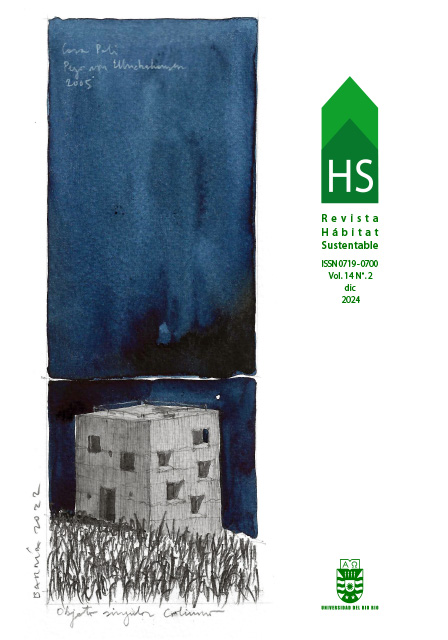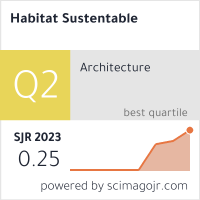Nature in spaces for older people: a biophilic approach, in the world
DOI:
https://doi.org/10.22320/07190700.2024.14.02.05Keywords:
biophilia, nature, older people, biophilic theoryAbstract
The study aims to find out how biophilia can condition the design of architectural spaces for older people. The research is descriptive, qualitative, and non-experimental, using a documentary review of the theoretical and architectural background to specify the subject of study, the behavior of the variable, and to identify architectural criteria. Five cases of empirical reality were analyzed to validate the criteria and obtain design guidelines. Similarly, one of the results obtained in the five cases became the guideline to generate terraces and natural, walkable outdoor spaces that create integration with open areas and connect with the natural environment, a guideline applied in 100% of the cases studied. It is concluded that biophilia conditions the design of spaces for older people by generating a fluid indoor/outdoor relationship through open and semi-open spaces, which includes nature and promotes social interaction among older people.
Downloads
References
ABDEL, H. (2023). Residencia para adultos mayores charm premier grand gotenyama / nikken housing system ltd. ArchDaily Perú. https://www.archdaily.pe/pe/1009812/residencia-para-adultos-mayores-charm-premier-grand-gotenyama-nikken-housing-system-ltd
ALBUQUERQUE, D., GOULART, F., KLAVDIANOS, N., GÜNTHER, I., y PORTELLA, A. (2023). Envelhecimento, sentido de lugar e planejamento urbano: Facilitadores e barreiras. Psicologia em Estudo, 28. https://doi.org/10.4025/psicolestud.v28i0.54416
ARAYA, A.-X., IRIARTE, E., RIOJA, R., y GONZÁLEZ, G. (2018). Programa Centros Diurnos del Adulto Mayor: Recomendaciones para mejorar su funcionamiento. Gerokomos, 29(1), 9-12. https://scielo.isciii.es/scielo.php?script=sci_abstract&pid=S1134-928X2018000100009&lng=es&nrm=iso&tlng=es.
ArchDaily. (2016). Skyville / woha. ArchDaily Perú. https://www.archdaily.com/800832/skyville-woha
BARAHONA-PICADO, M.-F. (2020). De la casa a la comunidad: Centro diurno para adulto mayor en Florencia de San Carlos [Proyecto de grado]. Instituto Tecnológico de Costa Rica, Escuela de Arquitectura y Urbanismo. https://repositoriotec.tec.ac.cr/handle/2238/12169
CASTRO, F. (2018). Kampung admiralty / woha. ArchDaily Perú. https://www.archdaily.pe/pe/905354/kampung-admiralty-woha
FAILOC ROJAS, R. J., y OJEDA CARRASCO, D. DEL J. (2022). Biofilia aplicada al diseño arquitectónico del Centro de atención del adulto mayor en el distrito de Zorritos—Tumbes, 2022 [Tesis de Pregrado]. Universidad César Vallejo. Facultad de Ingeniería y Arquitectura. https://repositorio.ucv.edu.pe/handle/20.500.12692/120343
FADDA, G., y CORTÉS, A. (2019). Hábitat y adulto mayor: El caso de Valparaíso. Revista INVI, 24(66), 89-113. https://doi.org/10.4067/S0718-83582009000200003
FAKHARANY, N. (2023). Comienza la construcción de La Serre, el oasis urbano de MVRDV en las afueras de París (Trad. M. Arellano). ArchDaily Perú. https://www.archdaily.pe/pe/1010087/comienza-la-construccion-de-la-serre-el-oasis-urbano-de-mvrdv-en-las-afueras-de-paris
GARCÍA-VALDEZ, M. T., SÁNCHEZ-GONZÁLEZ, D., y ROMÁN-PÉREZ, R. (2018). Envejecimiento y estrategias de adaptación a los entornos urbanos desde la gerontología ambiental. Estudios Demográficos y Urbanos, 34(1), 101-128. https://doi.org/10.24201/edu.v34i1.1810
GARECA APAZA, M. L. (2022). Biofilia: La naturaleza como factor de tendencia en el diseño de una vivienda. Revista Ciencia, Tecnología e Innovación, 20(26), 137-160. http://www.scielo.org.bo/scielo.php?script=sci_arttext&pid=S2225-87872022000200137
LEE, E.-J., y PARK, S.-J. (2022). Biophilic experience-based residential hybrid framework. International Journal of Environmental Research and Public Health, 19(14), 8512. https://doi.org/10.3390/ijerph19148512
LORENZO SURUCHAQUI, K. C. (2020). Aplicación del diseño biofílico en los espacios de centros de atención para el adulto mayor en Villa El Salvador [Tesis de Pregrado]. Universidad César Vallejo, Facultad de Ingeniería y Arquitectura. https://repositorio.ucv.edu.pe/handle/20.500.12692/87968
MARI, T., HUA, H., GUNASAGARAN, S., VERONICA, N., SRIRANGAM, S., y KUPPUSAMY, S. (2023). Biophilic design for elderly homes in Malaysia for improved quality of life. Journal of Engineering Science and Technology, 18, 96-112. https://jestec.taylors.edu.my/Special%20Issue%20THINK%20SPACE%202022/STAAUH%202022_09.pdf
MEDINA CHANGA, M., MIGLIORI OCHOA, L., y SORIA CABALLERO, G. (2023). Arquitectura biofílica: Influencia de su aplicación en el diseño de un centro residencial para el adulto mayor. Revista de Investigación Aporte Santiaguino Ingeniería e Innovación, 16(2), 154-165. https://doi.org/10.32911/as.2023.v16.n2.1058
MORENO-MATA, F. A., y SÁNCHEZ-MORENO, D. M. (2018). Ciudades biofílicas, espacios verdes y calidad de vida en la zona metropolitana de San Luis Potosí, México. RevistaLegado de Arquitectura y Diseño, (24), 48-59. https://www.redalyc.org/journal/4779/477957975007/html/
OSORIO BAYTER, L., y SALINAS RAMOS, F. (2016). El contexto y el centro residencial para las personas adultas mayores en Colombia y España. La empresa social Una alternativa para el bienestar. REVESCO. Revista de Estudios Cooperativos, 121, 205-227. https://doi.org/10.5209/rev_REVE.2016.v121.51307
PINILLA CÁRDENAS, M. A., ORTIZ ÁLVAREZ, M. A., y SUÁREZ-ESCUDERO, J. C. (2021). Adulto mayor: Envejecimiento, discapacidad, cuidado y centros día. Revisión de tema. Salud Uninorte, 37(2), 488-505. https://doi.org/10.14482/sun.37.2.618.971
QUISPE MENDIZABAL, D. H. (2023). Arquitectura biofílica en el diseño de áreas recreativas del Centro de Atención Social y Recreación del Adulto Mayor. DCGAL -2023 [Tesis de pregrado]. Universidad Privada de Tacna. http://repositorio.upt.edu.pe/handle/20.500.12969/3206
SANTOS, S. (2016). Asilo de Witherford Watson Mann promueve la sociabilidad entre adultos mayores (Trad. J. T. Franco). ArchDaily Perú. https://www.archdaily.pe/pe/780841/witherford-watson-manns-central-london-almshouse-promotes-sociability-for-the-elderly
TREVISAM, E., y SILVA DE OLIVEIRA, S. C. (2024). Contributions of biophilia to sustainable development. Veredas do Direito – Direito Ambiental e Desenvolvimento Sustentável, 21, e212408. https://doi.org/10.18623/rvd.v21.2408
TORRONTEGUI FIGUEROA, A. (2020). Reconociendo la biofilia en el hábitat residencial: El diseño arquitectónico como determinante de la percepción de la naturaleza en lo urbano [Tesis Pregrado]. Universidad de Chile, Facultad de Arquitectura y Urbanismo. https://repositorio.uchile.cl/handle/2250/180419
VILLALPANDO FLORES, A. E., y BUSTOS AGUAYO, J. M. (2023). La naturaleza urbana en las ciudades contemporáneas. La importancia del diseño biofílico en la salud pública. Academia XXII, 14(28), 8-29. https://doi.org/10.22201/fa.2007252Xp.2023.14.28.87234
XIAOXUE, S., y HUANG, X. (2024). Promoting stress and anxiety recovery in older adults: Assessing the therapeutic influence of biophilic green walls and outdoor view. Frontiers in Public Health, 12, 1352611. https://doi.org/10.3389/fpubh.2024.1352611
YUE, M., ZHANG, X., y ZHANG, J. (2024). Biophilic experience in high-rise residential areas in China: Factor structure and validity of a scale. Sustainability, 16(7), 2866. https://doi.org/10.3390/su16072866
ZANATTA, A. A., JOSÉ SANTOS-JUNIOR, R., PERINI, C. C., y FISCHER, M. L. (2019). Biofilia: Produção de vida ativa em cuidados paliativos. Saúde em Debate, 43(122), 949-965. https://doi.org/10.1590/0103-1104201912223
Downloads
Published
How to Cite
Issue
Section
License
Copyright (c) 2024 Hanlly del Pilar Velarde-Espinoza, Alberto Carlos Llanos-Chuquipoma

This work is licensed under a Creative Commons Attribution-ShareAlike 4.0 International License.
The content of articles which are published in each edition of Habitat Sustentable, is the exclusive responsibility of the author(s) and does not necessarily represent the thinking or compromise the opinion of University of the Bio-Bio.
The author(s) conserve their copyright and guarantee to the journal, the right of first publication of their work. This will simultaneously be subject to the Creative Commons Recognition License CC BY-SA, which allows others to share-copy, transform or create new materials from this work for non-commercial purposes, as long as they recognize authorship and the first publication in this journal, and its new creations are under a license with the same terms.











 Scientific Information Program/Concurso Fondos de Publicación de Revistas Científicas 2018/ Proyecto Mejoramiento de Visibilidad de Revistas UBB (Código:FP180007).
Scientific Information Program/Concurso Fondos de Publicación de Revistas Científicas 2018/ Proyecto Mejoramiento de Visibilidad de Revistas UBB (Código:FP180007).





